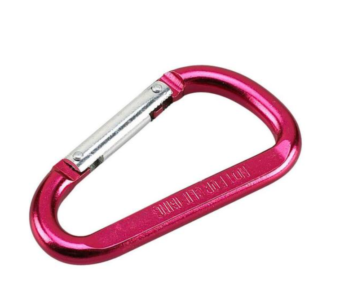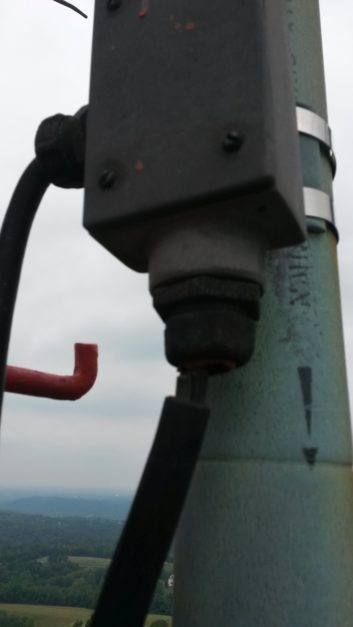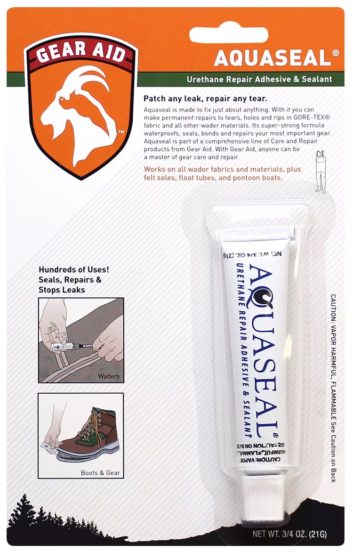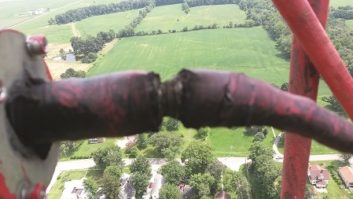
Chuck Weber, proprietor of Weber Climbing Services in Elizabethtown, Ind., is often asked for an opinion about a tower company or to recommend one. He answers that a company is only as good as its climbers.
Chuck shared some thoughts to help you get more value out of your next tower re-lamp job.
Ask the climbers to do a visual inspection and perform simple repairs on the way up and during their rest stops. It is an opportunity to gather some information that might save you thousands of dollars, so a little prep work may pay off big.
Some repairs, of course, will be limited by the climber’s knowledge and experience, but most will be commonsense.
A little small talk and a free lunch will make that initial conversation easier. You might also put together a small tool bag for the climber to take up. You can find a canvas bag and carabiner clip at a surplus or outdoor supply store.
In Chuck’s personal re-lamp tool bag, you’ll find a two-way radio as well as a cellphone. Never underestimate the importance of a means of quick and easy vocal contact, even if it’s just asking for AC power to check all the bulbs on the way down the tower.
The cellphone is not only a backup to the radio but it provides a camera to take photos of things that need attention and to document work done.
Also put a roll of quality electrical tape in the bag. Choose multi-use tape. It’s the “duct tape for the tower world,” and worth its weight in gold; it may mean the difference between doing a simple repair now and enduring a expensive failure later.
The electrical tape can provide temporary repairs for situations like the one here where an AC cable became separated from a radome heater.

Another “must-have” is a tube of Aquaseal urethane repair adhesive and sealant.
Use it to fix a poor or missing STL connector weather seal, or squeeze it into a poorly fit wire entry in a junction box. Like the electrical tape, the sealant can save you from early failures on many fronts.

In your bag, also include a coiled length of #14 solid conductor THHN wire, three to five feet of it. Rarely has Chuck been on a tower for a re-lamp and not found a section of coax hanging loose. The wire can be cut to length to create “copper tie wraps” that will last virtually forever.
Be sure to include a multi-tool/screwdriver combo, like the ones made by SOG, to tighten cable clamps or remove the base of a broken bulb from its fixture.
Finally, Chuck suggests that you supply extra bulbs to take up, at least one beacon and one side-lamp. Even new bulbs may fail when powered up; a few are bad out of the box.
You want the re-lamp to be done — with all new bulbs, not leaving an old bulb left in place because a new one failed. Having extras is cheap insurance, and any left over can be shelved for future use.
Thanks, Chuck, for helping us get our money’s worth out of the next re-lamp!
Basics Training
Frequent contributor Dan Slentz has been surfing the web again; he writes about a neat site called “Interesting Engineering” at www.interestingengineering.com.
The site offers an “Ultimate Electrical Engineering Master Class Bundle” that comprises five courses with more than 250 in-depth lessons. It promises to provide a solid understanding of electrical engineering tools and practices. The courses teach simple and complex circuits, as well as repair of household appliances; there’s even a course dedicated to the planning, installation and maintenance of solar power sources.
At this writing, the course is offered for $25
Dan adds that he did not have formal education in electronics; his training has come through the “school of hard knocks,” a Radio Shack 100-in-1 project kit, his antique Knight Kit “lab,” and attending programs such as the Sony school for U-Matic tape decks, Christie projection school and the Harris RF school.
He also has learned from reading sources like Radio World, TV Technology, the late Broadcast Engineering magazine and the super new online material provided by the Society of Broadcast Engineers. Dan adds that he still uses a cardboard three-wheel Radio Shack resistor value guide!
If you sign up for those courses or can recommend any others, share your experience by emailing me at [email protected].
John Bisset has spent over 50 years in the broadcasting industry. He handles western U.S. radio sales for the Telos Alliance. He holds CPBE certification with the Society of Broadcast Engineers and is a past recipient of the SBE’s Educator of the Year Award. Workbench submissions are encouraged, qualify for SBE Recertification, and can be emailed to [email protected].







